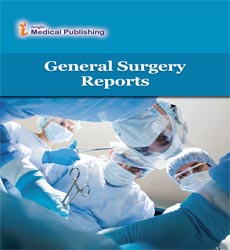Emergency General Surgery between Organ Transplant
Abiola Adedayo*
Department of Paediatric Surgery, St James's University Hospital, Leeds, UK
- *Corresponding Author:
- Abiola Adedayo
Department of Paediatric Surgery,
St James's University Hospital, Leeds,
UK,
E-mail: Abiola@gmail.com
Received date: November 13, 2023, Manuscript No. IPGSR-23-18474; Editor assigned date: November 15, 2023, PreQC No. IPGSR-23-18474 (PQ); Reviewed date: November 29, 2023, QC No. IPGSR-23-18474; Revised date: December 06, 2023, Manuscript No. IPGSR-23-18474 (R); Published date: December 13, 2023, DOI: 10.36648/ipgsr.7.03.141
Citation: Adedayo A (2023) Emergency General Surgery between Organ Transplant. Gen Surg Rep Vol.7 No.03:141.
Description
Transplantation stays the best quality level careful treatment for end-stage brokenness of a few organs. In like manner, the quantity of transfers performed yearly keeps on ascending with progressions in careful method, perioperative administration and immunosuppression systems have yielded fundamentally further developed endurance following transplantation. As a result, transplant recipients now appear more frequently in clinical settings. Critically, they may at last require care for nonrelocate related issues, for example, crisis general a medical procedure conditions, which incorporate harmless biliary illness, conditions including lysis of intra-stomach grips or dire entrail resection, a ruptured appendix and punctured ulcers. Strangely, relocate beneficiaries have as of late been displayed to all the more normally experience the ill effects of EGS conditions, This observation has been suggested to be caused by the higher prevalence of comorbidities and the requirement for lifelong immunosuppression in transplant recipients. An orderly survey by revealed that this cohort had a high rate of perioperative morbidity, ranging from 13.6 percent for biliary diseases to 32.7 percent for complicated diverticulitis.
Liver Transplant
Outstandingly, mortality in this gathering was 5.5% with overpowering sepsis referred to as the most well-known cause. Albeit earlier investigations have tried to describe the volume and results of relocate beneficiaries requiring EGS activities, they are generally restricted to single focuses or assess single circumstances. Additionally, there is a lack of information regarding the financial burden of hospitalizations and readmissions. The purpose of this population-based study was to assess the relationship between the clinical and financial outcomes of EGS operations and transplant recipient history. We theorized that earlier transplantation would be related with altogether higher in-emergency clinic mortality, asset usage and readmissions. The current review was a review examination of the 2010-2020 Cross country Readmissions Data set. The NRD is an all-payer, broadly delegate ongoing information base kept up with by the organization for medical services exploration and quality as a feature of the medical care cost and use task. The NRD gives assessments to roughly 59% of all ongoing hospitalizations in the US every year. The data set contains linkage numbers for all inspected patients, taking into consideration readmissions inside each schedule year to be followed across clinics. The review was considered absolved from full audit by the institutional survey board at the college of california, los angeles because of its recognized nature. Utilizing pertinent worldwide characterization of illness, 10th and tenth corrections codes, hospitalizations for grown-ups who went through normal crisis general a medical procedure tasks were recognized. Systems of interest included enormous/little inside resection, fix of punctured ulcer, cholecystectomy, appendectomy and lysis of bonds, as recently announced. Patients who had transplants in the past were divided into kidney/pancreas groups. Pancreas was assembled with kidney transfers because of the great paces of associative kidney-pancreas transplantation. Cholecystectomy-related liver transplant recipients or elective admission patients were excluded.
Clinic Qualities
Patient and emergency clinic qualities, for example, age; sex, payer type, pay level and showing status were characterized by the NRD information word reference. Comorbidities were classified utilizing pertinent ICD-9/10 conclusion codes. The changed Elixhauser Comorbidity List, a formerly approved composite score of 30 comorbidities utilizing ICD coding, was utilized to measure the weight of persistent circumstances with higher scores comparing to more noteworthy seriousness. To represent focus insight, medical clinics were isolated into textiles in light of institutional EGS activity caseload. Analysis Related Gatherings in mix with ICD codes were utilized to recognize head readmission analyze. The essential result was in-emergency clinic mortality. Auxiliary results included perioperative intricacies, emergency unit confirmation, hospitalization costs, length of stay, and 30-day non-elective readmission. We additionally tried to assess factors related with relocate related entanglements dismissal, disappointment, join disease. Confusions of interest included stroke, heart failure, ventricular arrhythmia, tamponed, thrombotic (profound vein apoplexy, aspiratory embolism), respiratory (pneumonia, intense respiratory disappointment, delayed mechanical ventilation), irresistible (sepsis, septicemia, careful site disease), and intense kidney injury. Costs were determined by use of emergency clinic explicit expense to-charge proportions to generally speaking hospitalization accuses given by HCUP of expansion change utilizing the 2020 Department of Work Insights Shopper Value Record. Persistent factors are accounted for as middle with Interquartile Range (IQR) while straight out factors are accounted for as extents. The Mann-Whitney-U and Pearson chisquare tests were used to compare the characteristics of the cohorts. Multivariable calculated and direct relapse models were created to assess the relationship of relocate type with results of interest. Entropy balancing was used to create a weighted comparison group with similar covariate distributions in order to account for differences between groups. Versatile Net with maintenance of clinically significant attributes was utilized for variable determination.
Open Access Journals
- Aquaculture & Veterinary Science
- Chemistry & Chemical Sciences
- Clinical Sciences
- Engineering
- General Science
- Genetics & Molecular Biology
- Health Care & Nursing
- Immunology & Microbiology
- Materials Science
- Mathematics & Physics
- Medical Sciences
- Neurology & Psychiatry
- Oncology & Cancer Science
- Pharmaceutical Sciences
